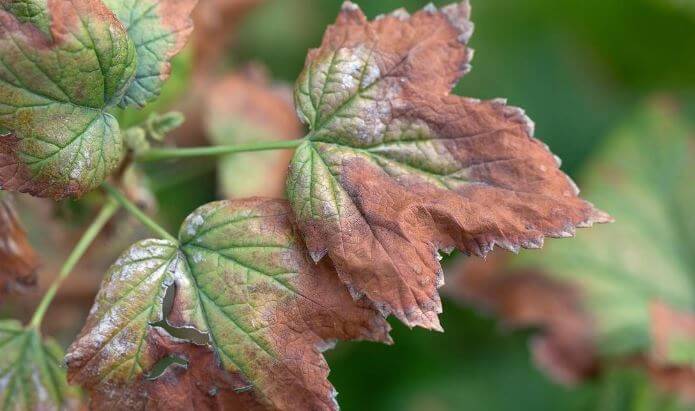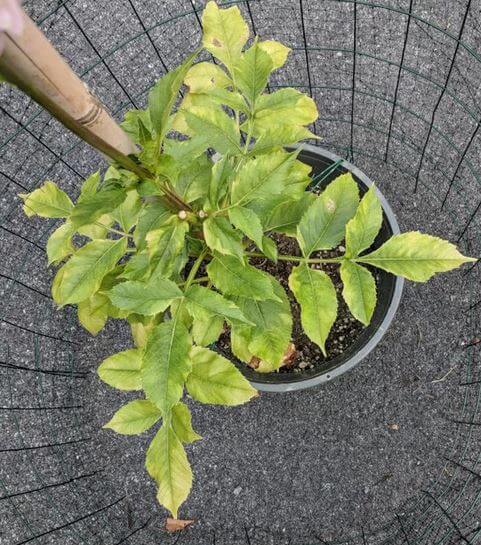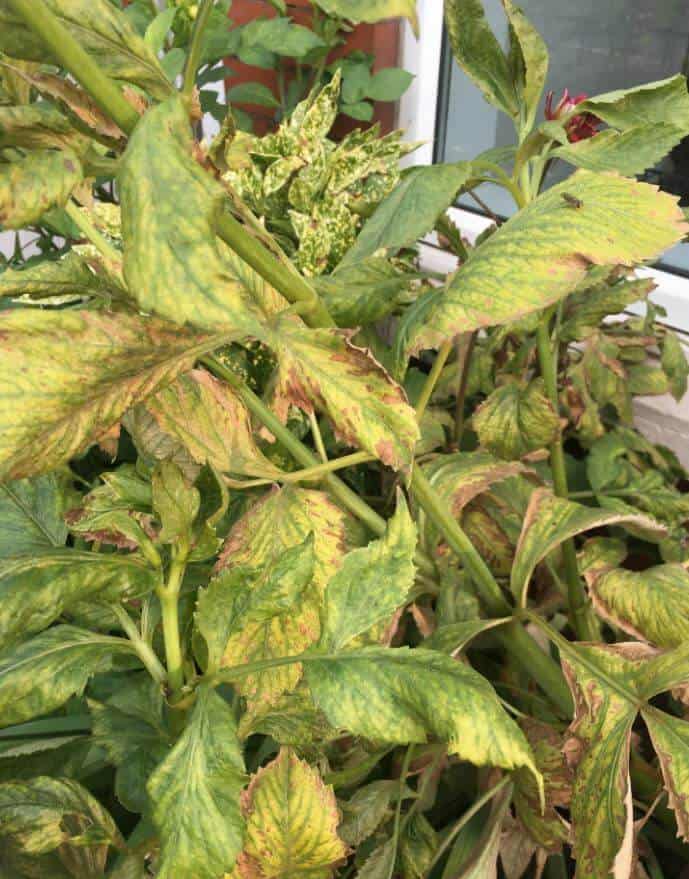Last Updated on September 9, 2023 by a Friendly Gardener
Late-season bloomers, dahlia plants come in numerous patterns, colors, forms, and sizes from compact to more than 6 feet in height. Members of the Asteraceae family, most dahlias will appear on long stems that grow in an erect fashion. This growth habit is the perfect method for Mother Nature to show off the famous blossoms.
Dahlias find their native habitat in Central America and Mexico with more than 30 species and 20,000 cultivars. These flowering plants are so popular that entire events are dedicated to them. Perennial plants only in tropical climates, Dahlias are annuals everywhere else. Grown from tubers, they are relatively easy to cultivate. However, should your Dahlia manifest yellow foliage, it is communicating that it is distressed. Dahlia yellow leaves are not uncommon and may be caused by environmental conditions, poor soil, pests, or disease among others. The important thing is to determine the cause.
The Causes of Yellowing Leaves on Dahlias

There are multiple causes for yellowing foliage on these plants, therefore you’ll need to investigate to discover the reason. Should yellowing appear toward the end of the growing season, it may just be that your plant is preparing to enter dormancy.
If yellowing begins at the beginning of the growing season, you may have an environmental problem such as improper soil or light.
Improper Dahlia Watering

Dahlia leaves turning yellow and brown indicate a problem with watering that can be either excessive watering or a lack of watering.
Dahlias should never be permitted to dry out. They require a consistent watering schedule. If your Dahlia leaves yellow and droops with brown tips, excessive watering is generally the reason. Plant tubers can easily become waterlogged in soggy soil and their vascular systems may become clogged consequentially. Without intervention, tubers can become ill with root rot.
If your plant is underwatered, leaves will appear yellow, dry, and crunchy. The Dahlia is not drought resistant. A typical symptom of underwatering is the curling downward of leaf edges.
Check soil bed moisture regularly. This can be accomplished with a moisture meter or by poking the soil with your finger. Soil should never be wet below two inches in depth. If the top two inches of the soil are dry, water more frequently. If the soil is too wet, reduce your watering schedule.
During blooming, Dahlias need about two inches of water weekly. The rest of the time one inch of water will suffice. You will need to water one to three times weekly. Your best option will be a slow soaker hose.
Improper Soil

Dahlias thrive in a soil bed that is loose and well-draining. Clay soils are not recommended as they can clog tubers and cause root rot. Check your garden soil by grabbing a fistful at least six inches deep and closing your fist. When soil binds into a ball, it has too much clay.
If your garden bed has too much clay, you will need to amend it with a generous amount of organic material. This process will need to be repeated for years. Amend your soil before you plant your Dahlias.
If you believe the soil is the reason for Dahlia yellow leaves, amend the top six inches of soil with organic matter. You can also use a stick to poke holes in the vicinity of your plants to render them more porous.
Soil pH
Dahlias like slightly acidic soil pH, so your soil should ideally measure a 6.5 pH level. If the soil pH is low, amend the soil with lime. Garden centers will generally sell liquid, pellet, or powder lime for this reason. Blend it into the top six inches of the soil.
For an alkaline pH that is too high, blend in peat moss or sulfur-based products for an acidity increase.
Nutritional Issues

Should foliage appear yellow but maintain green veining, your plant is most likely suffering from a nutrient deficiency. Use a soil test to evaluate the condition of the soil. The most common deficiency is magnesium. Epsom salts worked into the soil can rectify this together with organic material rich in magnesium. A magnesium deficiency is often manifested by older foliage suffering as opposed to new growth.
An iron deficiency is another possibility. Work chelates or sulfur into the soil bed to increase iron. You can apply an iron supplement to leaves or directly into the soil bed as well.
Fertilizers with a high potassium content can disturb both magnesium and iron levels, so select one with less potassium when fertilizing.
Dahlia Leaves Turning Yellow from Disease

A disease can also cause foliage to turn yellow. The most common diseases to afflict these plants are root rot and fungal infections.
In the case of root rot, Dahlia tubers will rot and no longer be able to sustain the plant. Foliage will fade and then slowly begin to turn yellow. Although there is no shortage of infections that can strike Dahlia, common diseases include:
-
Chlorosis
If a Dahlia is unable to produce adequate chlorophyll, leaves will turn yellow.
-
Mosaic disease or Dahlia Foe
Usually transmitted by tools or aphids, this is a deadly viral illness. The mosaic disease is easily recognized for the irregularly shaped patches found on leaves.
-
Dahlia Smut
This is a fungal infection that provokes yellow mottling on foliage. High humidity facilitates this infection.
-
Verticillium wilt
This illness is vascular and will cause fading and wilting of foliage. Plants and the soil they grow in should be removed.
The best cure is prevention by keeping your plant healthy.
Dahlia Leaves Yellow from Pest Infestations
Like most plants, the Dahlia is susceptible to attacks from a variety of pests. Among the most common pests we find
-
Aphids
These insects are capable of turning leaves yellow, but the foliage will also be characterized by stunted or twisted growth.
-
Armored scales
-
Leafhoppers
These parasites are the most common pests to attack the Dahlia. They feed on foliage and transmit infections causing foliage to yellow.
-
Mites
Mites are sapsuckers. They will attack lower leaves and those that are partially shaded. These sapsuckers will cause a lot of damage but usually are not fatal.
-
Slugs and snails
Beer traps or manual removal are the most effective.
-
Thrips
Pests can be contrasted by spraying your plant with jets of water that wash them away. Neem oil or insecticidal soaps are also exceptionally efficacious in removing pest infestations.

